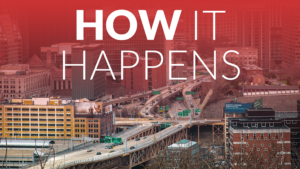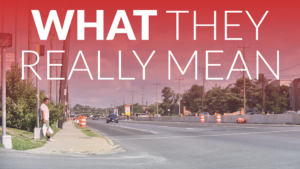Related Resources
Community Connectors Portal: Tools for advocates > How things happenQuick builds

Quick builds, also known as demonstration projects or tactical urbanism, are temporary installations to test new street design improvements that improve safety and accessibility. Quick-build projects prioritize affordable, rapid, and temporary solutions to inaccessible and unsafe streetscape conditions. Through this approach to building and designing streets, communities are able to set an example that establishes the need and precedent for continued change. They take lots of forms. Quick-builds can be super quick and flexible, can use heavier materials, and can be incredibly cheap or more substantial.
Why do a quick build demonstration project?
These quick, light, flexible, and adaptable projects use designs that are proven to make streets safer, and they have numerous benefits:
1. Improve safety overnight on dangerous corridors or intersections
Because these projects use cheap and easily accessible materials, they are easy to set-up. This results in a quick implementation time frame that can demonstrate significant improvements to road safety virtually overnight.
2. Cheaply test specific designs, interventions, and materials
If a community is unsure of how to approach a road safety challenge, quick-builds offer an opportunity for a test-run. In the case that the proposed solution is not effective, communities have spent limited time and resources on the project, making it easy to pivot and learn from mistakes.
3. Engage everyone involved throughout the process—community members, transportation staff, elected leaders
The first step to any successful initiative is collaboration and support across jurisdictions. These relationships can be fostered through the shared goal of implementing a quick-build project.
4. Develop new knowledge and partnerships
While developing cross jurisdictional relationships throughout project development and implementation, the community can learn from different perspectives and have a stronger network going into future projects.
5. Develop new knowledge and partnerships
Much like the ability to cheaply test and experiment with different solutions, these projects also offer the ability to hear from residents and other stakeholders how their livelihoods are impacted by the project.
6. Build support for an even better permanent project
When a quick-build goes well, you have now created momentum and support to acquire support and funding for projects using longer-lasting materials. Additionally, this support can be used to push a bit further and try even more ambitious projects.
7. Encourage the use of other transportation modes or different travel patterns
The excitement around quick-builds gets people excited about transportation! People now have the option to change their habits because your project made it possible.
How to do a quick-build demonstration project
Mike Lydon and Anthony Garcia’s landmark book, Tactical Urbanism: Short-term Action for Long-term Change, illustrates examples of how the approach can be utilized and includes a toolkit to guide project planning and implementation. According to the guide, any initiative utilizing Tactical Urbanism should consist of three main principles: safety enhancement, ability to adapt across project implementation, and constant innovation. Additionally, the free Tactical Urbanist’s Guide to Materials and Design provides detailed information on what principles to consider when project planning, how to choose project materials, and programming examples to bring your project to life.
Fayetteville, Arkansas has also developed a guide to community-led tactical urbanism which helps residents plan and implement projects. While some of the included information in the guide is specific to city processes, the guide offers insight into what should be considered throughout quick-build installation and evaluation.
The Better Block Foundation also has good resources for quick-build implementation. Check out their open source design library, Wikiblock, for access to free designs for benches, chairs, planters, stages, bus stops, beer garden fences, and kiosks that can be easily cut from plywood and constructed with a mallet. You can also explore their website to discover more resources like their “better block in a box” and how to hire the organization to help revitalize your community.
Cases to reference
Over the last decade and through a number of initiatives, The National Complete Streets Coalition at Smart Growth America has assisted 22 places across 14 states with their quick-build projects. You can read reports about some of those programs below:
- Safe Streets Academy (2017-2018)
- Safe Streets, Smart Cities Academy (2018-2019)
- Washington Complete Streets Leadership Academy (2020-2021)
- Complete Streets Leadership Academies (2022-2024)
How can I fund a quick build?
A good first place to find funding for quick-build projects is on your local or state government website. Many states and cities have local funds designated for these kinds of projects and may also have resources available to support your project.
Additionally, a new federal grant program that can support quick-build projects is currently accepting applications! The Safe Streets and Roads for All (SS4A) program can provide funding for quick-build demonstrations, and there are more than a billion dollars available, provided directly to local communities. The deadline to apply for a Planning and Demonstration Grant is August 29th. Here are six things to know about the SS4A grant program:
-
- Nearly $1 billion is available in planning grants that can also support quick-build demonstration projects
- You can do a lot of quick-builds with just a little bit of money
- The application process is one of the simplest you will see from USDOT
- These funds are awarded directly to a local jurisdiction, or to multiple jurisdiction in a joint application
- The planning money has not been competitive to date — it is undersubscribed
- If you want a future implementation grant, you will either need a planning grant now, or an USDOT-approved safety plan







